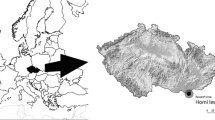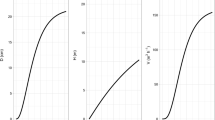Abstract
We carried out a study to determine if bark type could reflect the growth potential of yellow birch (Betula alleghaniensis Britt.) and sugar maple (Acer saccharum Marsh.) at the northern limit of their range in Québec, Canada (47°N, 75°W). We measured a large sample of 266 trees that ranged in size from 95 to 712 mm in diameter at breast height, on two independent study sites. Our results suggest that trees with smooth bark type had mean 5-year diameter increment 8 and 11 mm higher than trees with rough bark type, depending upon the study site. Differences in growth of 8 and 11 mm represented 85% of the overall rough bark type increment in the first site and 78% of the overall rough bark type increment in the second site. The rapid identification of a tree’s growth potential using bark type could be of great use to practitioners because it avoids the need to bore trees to collect increment cores, which injures trees and may serve as an entry point for disease. Moreover, the proposed method helps protect or release the smallest trees with high growth potential and remove trees with low growth potential. While the proposed method is valuable to practitioners operating in uneven-aged forests, its applicability still needs to be tested in even-aged forests.




Similar content being viewed by others
References
Arbogast C Jr (1957) Marking guides for northern hardwoods under the selection system. USDA For Serv, Station Pap LS-56, St Paul
Bédard S, Majcen Z (2001) Ten-year response of sugar maple-yellow birch-beech stands to selection cutting in Québec. North J Appl For 19:119–126
Beineke WF (1989) Twenty years of black walnut genetic improvement at Purdue University. North J Appl For 6:68–71
Binkley D, Stape JL, Ryan MG, Barnard HR, Fownes JH (2002) Age-related decline in forest ecosystem growth: an individual-tree, stand-structure hypothesis. Ecosystems 5:58–67
Boisvert-Marsh L, Périé C, De Blois S (2014) Shifting with climate? Evidence for recent changes in tree species distribution at high latitudes. Ecosphere 5:83
Clausen KE, Godman RM (1969) Bark characteristics indicate age and growth rate of yellow birch. USDA For Serv, Res Note NC–75, St Paul
Fortin M, Bédard S, DeBlois J, Meunier S (2008) Accounting for error correlations in diameter increment modelling: a case study applied to northern hardwood stands in Quebec, Canada. Can J For Res 38:2274–2286
Gauthier M-M, Jacobs DF (2010) Northern red oak, white oak, and black walnut diameter growth for the first 3 years after thinning in a mixed planting. North J Appl For 27:110–116
Hoyle MC (1965) Variation in foliage composition and diameter growth of yellow birch with season, soil, and tree size. Soil Sci Soc Am J 29:475–480
Jacobs DF (2007) Toward development of silvical strategies for forest restoration of American chestnut (Castanea dentata) using blight-resistant hybrids. Biol Conserv 137:497–506
Junikka L (1994) Survey of English macroscopic bark terminology. IAWA J 15:3–45
Lamit LJ, Lau MK, Naesborg RR, Wojtowicz T, Whitham TG, Gehring CA (2015) Genotype variation in bark texture drives lichen community assembly across multiple environments. Ecology 96:960–971
Lawes MJ, Richards A, Dathe J, Midgley JJ (2011) Bark thickness determines fire resistance of selected tree species from fire-prone tropical savanna in north Australia. Plant Ecol 212:2057–2069
López-Villalobos A, Flores-Palacios A, Ortiz-Pulido R (2008) The relationship between bark peeling rate and the distribution and mortality of two epiphyte species. Plant Ecol 198:265–274
Messier C, Nikinmaa E (2000) Effects of light availability and sapling size on the growth, biomass allocation, and crown morphology of understory sugar maple, yellow birch, and beech. Ecoscience 7:345–356
Milliken GA, Johnson DE (2009) Chapter 6.2 Least squares estimation. In: Analysis of messy data. Volume 1—Designed experiments, 2nd edn. CRC Press, pp 161–169
Nyland RD (1996) Silviculture: concepts and application. McGraw Hill, New York
OMNR (1983) Management of tolerant hardwoods in Algonquin Provincial Park. Ontario Ministry of Natural Resources and Forestry, Queen’s Printer for Ontario, Toronto
OMNR (2004) Ontario tree marking guide. Version 1.1. Ontario Ministry of Natural Resources and Forestry, Queen’s Printer for Ontario, Toronto
Ouimet R, Duchesne L, Moore J-D (2017) Response of northern hardwoods to experimental soil acidification and alkalinisation after 20 years. For Ecol Manag 400:600–606
Prévost M, Gauthier M-M (2012) Precommercial thinning increases growth of overstory aspen and understory balsam fir in a boreal mixedwood stand. For Ecol Manag 278:17–26
Raymond P, Bédard S, Roy V, Larouche C, Tremblay S (2009) The irregular shelterwood system: review, classification, and potential application to forests affected by partial disturbances. J For 107:407–413
Régnière J, Saint-Amant R, Béchard A (2014) BioSIM 10—user’s manual. Nat Resour Can, Can For Serv, Inf Rep LAU-X-137E, Québec
Rosell JA (2016) Bark thickness across the angiosperms: more than just fire. New Phytol 211:90–102
Rosell JA, Gleason S, Méndez-Alonzo R, Chang Y, Westoby M (2014) Bark functional ecology: evidence for tradeoffs, functional coordination, and environment producing bark diversity. New Phytol 201:486–497
Ross-Davis AL, Huang Z, McKenna J, Ostry M, Woeste K (2008) Morphological and molecular methods to identify butternut (Juglans cinerea) and butternut hybrids: relevance to butternut conservation. Tree Physiol 28:1127–1133
Ryan MG, Binkley D, Fownes JH (1997) Age-related decline in forest productivity: pattern and process. Adv Ecol Res 27:213–262
Sajdak RL (1968) Variation in bark characters and wood specific gravity in sugar maple. In: Wright JW (ed) Proceedings of the Eighth Lake States Forest Tree Improvement Conference, 12–13 Sept 1967, Madison, WI. USDA For Serv, Res Pap NC–23, St Paul, pp 10–14
SAS Institute Inc (2009) SAS/STAT® 9.2 User’s guide, 2nd edn. SAS Institute Inc., Cary
Schubert AT, Nano CEM, Clarke PJ, Lawes MJ (2016) Evidence for bark thickness as a fire-resistance trait from desert to savanna in fire-prone inland Australia. Plant Ecol 217:683–696
Schweingruber FH (2012) Tree rings: basics and applications of dendrochronology. Klewer Academic Publishers, Dordrecht
Smith FW, Long JN (2001) Age-related decline in forest growth: an emergent property. For Ecol Manag 144:175–181
Wei X, Borralho NMG (1997) Genetic control of wood basic density and bark thickness and their relationships with growth traits of Eucalyptus urophylla in south east China. Silva Genet 46:245–250
Westfall PH, Tobias RD, Wolfinger RD (2011) Multiple comparisons and multiple tests using SAS, 2nd edn. SAS Institute, Cary
Acknowledgements
We thank Jocelyn Hamel, Pierre Laurent, Jean-François Leblond, William Michaud, and Aurélien Stique for their help in establishing the study and data collection. We thank Marie-Claude Lambert for advice on statistical analyses. We appreciate comments and suggestions from Dr. William E. Rogers and two anonymous reviewers that helped improve the quality of this manuscript. Funding for this study was provided by the Ministère des Forêts, de la Faune et des Parcs du Québec, under Project Number 142332048 (François Guillemette).
Author information
Authors and Affiliations
Corresponding author
Additional information
Communicated by Jan Wunder.
Rights and permissions
About this article
Cite this article
Gauthier, MM., Guillemette, F. Bark type reflects growth potential of yellow birch and sugar maple at the northern limit of their range. Plant Ecol 219, 381–390 (2018). https://doi.org/10.1007/s11258-018-0802-x
Received:
Accepted:
Published:
Issue Date:
DOI: https://doi.org/10.1007/s11258-018-0802-x




